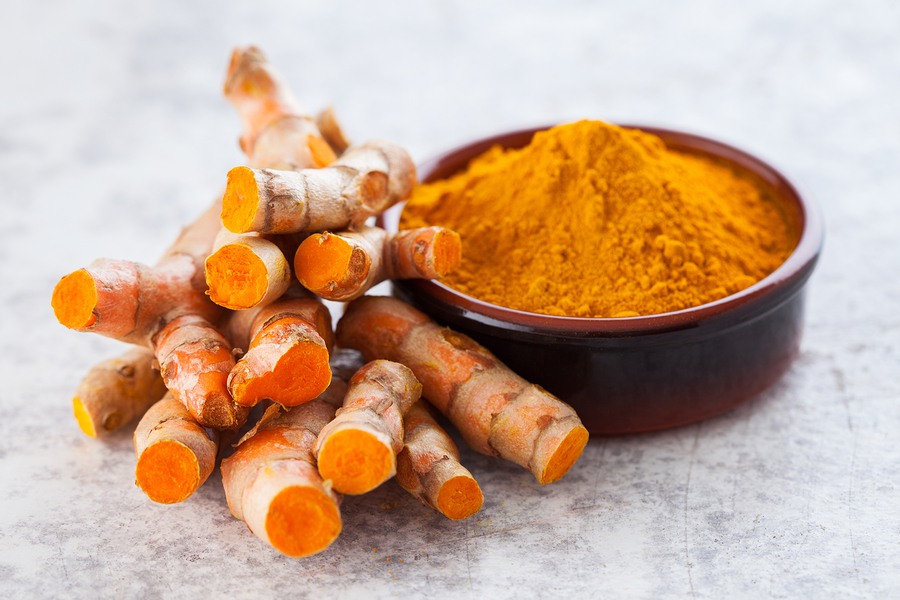Turmeric (Curcuma longa) is the golden-orange spice that gives curried foods pizzazz. In Traditional Chinese and Indian Medicine, turmeric is used to treat allergies, digestive ailments, and pain. The active chemical component of turmeric is curcumin, known for its anti-inflammatory properties. Today, research is focused on the role curcumin plays in diseases where the underlying factor is inflammation, such as in heart disease and arthritis.
Studies show that curcumin blocks inflammation at the cellular level. Some studies indicate that curcumin’s role in preventing joint inflammation surpasses its ability to reduce active joint inflammation. In clinical trials, standardized curcumin supplements helped improve pain and swelling in patients with RA. These promising results are being further investigated in long-term studies.
Including turmeric in your diet is easy to do and, oh, so flavorful. Add turmeric to soups and dressings; sprinkle over meats, veggies, and scrambled eggs; add it to plain yogurt or a smoothie.
While adding turmeric spice to your meals is a great first step, the amounts used in cooking do not provide the therapeutic levels needed to achieve its robust health effects. When considering the addition of turmeric to your health plan, work with your holistic health practitioner to determine if this is a good choice and which curcumin supplement is best for you. He or she can recommend the right form (capsule or powder) that will have the best bioavailability – meaning it’s easy for your body to process through the digestive tract – for your specific health needs.
References
- ArthritisFoundation.org “Turmeric.” Accessed 19 Apr 2018: https://www.arthritis.org/living-with-arthritis/treatments/natural/supplements-herbs/guide/turmeric.php
- Anand, P., Kunnumakkara, A. B., Newman, R. A., & Aggarwal, B. B. “Bioavailability of curcumin: problems and promise.” Molecular Pharmaceutics, (2007). 4(6), 807-818. Accessed 19 Apr 2018: https://pubs.acs.org/doi/abs/10.1021/mp700113r
- Chandran, B., & Goel, A. “A randomized, pilot study to assess the efficacy and safety of curcumin in patients with active rheumatoid arthritis.” Phytotherapy Research,(Nov 2012). 26(11), 1719-1725 Accessed 19 Apr 2018: https://onlinelibrary.wiley.com/doi/abs/10.1002/ptr.4639
- OrgegonState.edu “Curcumin.” Accessed 19 Apr 2018: http://lpi.oregonstate.edu/mic/dietary-factors/phytochemicals/curcumin
- Ghosh, S., Banerjee, S., & Sil, P. C. (2015, September). “The beneficial role of curcumin on inflammation, diabetes and neurodegenerative disease: A recent update.” Food & Chemical Toxicology, 83, 111-124. Accessed 19 Apr 2018: https://www.ncbi.nlm.nih.gov/pubmed/26066364
- Schaffer, M., Schaffer, P. M., Zidan, J., & Bar Sela, G. “Curcuma as a functional food in the control of cancer and inflammation.” Current Opinion in Clinical Nutrition & Metabolic Care, (2011, November). 14(6), 588-597 Accessed 19 Apr 2018: https://insights.ovid.com/pubmed?pmid=21986478
- Yasuda, G., et al., “Rheumatoid Arthritis” in Textbook of Natural Medicine by Pizzorno, Joseph E. & Michael T. Murray. (Chapter 205, p 1769). (2013) St. Louis, MO Elsevier.
- Johnson, R.L., S. Foster, Low Dog, T. and Kiefer, D. National Geographic Guide to Medicinal Herbs: The World’s Most Effective Healing Plants.(2012) Washington, D.C.: National Geographic.

